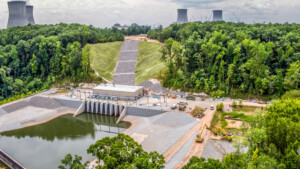Challenge
Plant Vogtle Units 3 and 4 were the first new nuclear units built in the United States in the last three decades. Therein lies a unique challenge—designing and building a project to the stringent requirements established by the Nuclear Regulatory Commission (NRC). Additionally, working at an active nuclear site presented its own unique challenges.
The design of the raw water structure (RWS) piping system, communication, and power system first contemplated traversing up the side of a 1:1 bluff directly adjacent to the intake structure. These systems would be excavated, shored, placed, and backfilled using standard industry practices for this type of work. The steepness of the bluff would have been difficult and a bit of a challenge but certainly feasible.
Upon analysis of the soil borings, it was determined that bluff material would most likely slide if disturbed using the construction method described. Garney and Burns & McDonnell—working closely with Georgia Power—elected to design an open cut for the bluff and remove the unsuitable material and allow for the systems to be installed on a 3:1 slope plated with rip rap.
The greatest challenge of this redesign was diverting the flow of surface water that, for years, had simply drained off the side of the bluff into the Savannah River. A robust drainage system was incorporated in the redesign. As with all projects, environmental impact was a major concern. The protection of the Savannah River and the surrounding area included a three-phase erosion control plan throughout the construction process.
Approach
Due to the complexity and magnitude of the project, Georgia Power understood the necessity of bringing in a design-build team experienced in this type of work.
The Garney/Burns & McDonnell project team demonstrated to Georgia Power that they were the best qualified and most knowledgeable of the site and project conditions to meet the aggressive completion schedule.
Initially, the project design scope was comprised of three major components:
1. Design of a 7,300-square-foot pump house and switchgear building resting atop the intake structure, which housed the facility’s switchgear and six 660 horsepower (HP) vertical turbine pumps
2. Design of the dual 36-inch raw water structure pipelines from the intake structure to a tie-in point at Units 3 and 4
3. Design of the power and communications paralleling the pipelines
Originally, the raw water intake structural design was not part of the design scope; however, with the NRC’s modified seismic requirements, a redesign was necessary. Based on the team’s design efforts and in-depth knowledge of the project to that point, the owner reached out to the project team to redesign the rebar yet maintain the geometry and functionality of the structure. One would expect this to add cost to the project; however, with Burns & McDonnell’s design expertise and Garney’s constructability input, the owner realized a significant savings in both cost and schedule.
Throughout the project, the Garney/Burns & McDonnell project team demonstrated its ability and willingness to work with the owner no matter what challenge or issue arose. Based on the results of this collaborative approach, the client again turned to the project team and added the turnkey services to include all process mechanical and electrical for the raw water intake structure to achieve a demanding turnover milestone date.
This project was the first system to be turned over to the owner. Working closely with the owner, the project team developed and refined a comprehensive turnover procedure and protocol that to this day is still being used as the benchmark for other system turnovers at this site.
Results
The collaborative efforts of Garney, Burns & McDonnell, and Georgia Power allowed for the successful completion of the raw water intake structure (RWIS) on schedule.
Units 3 and 4 are expected to generate 17,200,000 megawatt-hours of clean energy and prevent 10 million metric tons of carbon dioxide emissions annually.
Plant Vogtle is part of the United States’ efforts to achieve net-zero emissions by 2050.
US nuclear technology safety standards are the highest in the world. Successful completion of this project will help reassert America as an international leader in innovation and strengthen the nation’s energy and national security.







